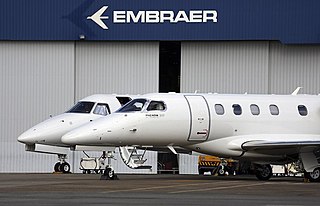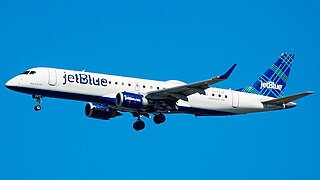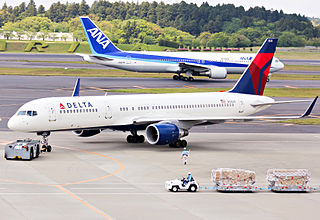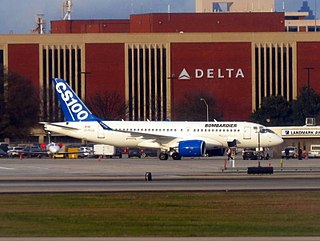
Embraer S.A. is a Brazilian multinational aerospace corporation. It designs, manufactures, and sells commercial, military, executive, and agricultural aircraft, as well as provides leasing and aviation support services. Embraer is the third largest producer of civil aircraft after Boeing and Airbus, and the leading provider of regional jets worldwide; it is also among the world's top 100 defense contractors. The company is headquartered in São José dos Campos, São Paulo.

ATR is a Franco-Italian aircraft manufacturer headquartered in Blagnac, France, a suburb of Toulouse.

The ATR 72 is a twin-engine turboprop, short-haul regional airliner developed and produced in France and Italy by aircraft manufacturer ATR, a joint venture formed by French aerospace company Aérospatiale and Italian aviation conglomerate Aeritalia. The number "72" in its name is derived from the aircraft's typical standard seating capacity of 72 passengers.

A regional airliner or a feederliner is a small airliner that is designed to fly up to 100 passengers on short-haul flights, usually feeding larger carriers' airline hubs from small markets. This class of airliners is typically flown by the regional airlines that are either contracted by or subsidiaries of the larger airlines. Regional airliners are used for short trips between smaller towns or from a larger city to a smaller city. Feederliner, commuter, and local service are all alternative terms for the same class of flight operations.

The British Aerospace ATP is an airliner designed and produced by British Aerospace. It was an evolution of the Hawker Siddeley HS 748, a fairly successful feederliner of the 1960s.

The De Havilland Canada DHC-8, commonly known as the Dash 8, is a series of turboprop-powered regional airliners, introduced by de Havilland Canada (DHC) in 1984. DHC was later bought by Boeing in 1988, then by Bombardier in 1992; then by Longview Aviation Capital in 2019, reviving the De Havilland Canada brand. Powered by two Pratt & Whitney Canada PW100s, it was developed from the Dash 7 with improved cruise performance and lower operational costs, but without STOL performance. Three sizes were offered: initially the 37–40 seat -100 until 2005 and the more powerful -200 from 1995, the stretched 50–56 seats -300 from 1989, both until 2009, and the 68–90 seats -400 from 1999, still in production. The QSeries are post-1997 variants fitted with active noise control systems.

The Embraer E-Jet family is a series of four-abreast, narrow-body, short- to medium-range, twin-engined jet airliners designed and produced by Brazilian aerospace manufacturer Embraer.

A regional jet (RJ) is a jet-powered regional airliner with fewer than 100 seats. The first one was the Sud-Aviation Caravelle in 1959, followed by the widespread Yakovlev Yak-40, Fokker F-28, and BAe 146. The 1990s saw the emergence of the most widespread Canadair Regional Jet and its Embraer Regional Jet counterpart, then the larger Embraer E-Jet and multiple competing projects. In the US, they are limited in size by scope clauses.

A hydrogen-powered aircraft is an aeroplane that uses hydrogen fuel as a power source. Hydrogen can either be burned in a jet engine or another kind of internal combustion engine, or can be used to power a fuel cell to generate electricity to power an electric propulsor. It cannot be stored in a traditional wet wing, and hydrogen tanks have to be housed in the fuselage or be supported by the wing.

The Bombardier CRJ700, CRJ900, and CRJ1000 are a family of regional jet airliners that were designed and manufactured by Canadian transportation conglomerate Bombardier between 1999 and 2020. Their design was derived from the smaller CRJ100 and 200 airliners, the other members of the Bombardier CRJ aircraft family. The CRJ program was acquired by the Japanese corporation Mitsubishi Heavy Industries in 2020, which ended production of the aircraft.

The Mitsubishi SpaceJet was a regional jet project by Japanese company Mitsubishi Aircraft Corporation (MAC), a Mitsubishi Heavy Industries (MHI) subsidiary. MHI first announced the concept in June 2007, then targeting certification for 2012, as the first Japanese airliner since the 1962 NAMC YS-11. After a delayed development, the maiden flight of the MRJ90 took place on 11 November 2015. In June 2019, Mitsubishi rebranded the Mitsubishi Regional Jet program as the SpaceJet. As flight testing took longer than expected, the scheduled entry into service was further pushed back until development was first paused in October 2020, and subsequently cancelled altogether in February 2023.
The Xian MA700 is a twin-engine, medium-range turboprop airliner currently under development by Xi'an Aircraft Industrial Corporation of the Aviation Industry Corporation of China (AVIC).
The HAL/NAL Regional Transport Aircraft (RTA) or Indian Regional Jet (IRJ) is a regional airliner being designed by India's National Aerospace Laboratories (NAL) and to be manufactured by Hindustan Aeronautics Limited (HAL). The aircraft is planned to be a turboprop or a jet with a capacity of 80–100 passengers. Its basic version will have 80–90 seats (RTA-70) and the cost of the airliner will be 20 percent lower compared to its global competitors.

A scope clause is part of a contract between a major airline and the trade union of its pilots that limit the number and size of aircraft that may be flown by the airline's regional airline affiliate.

The fuel economy in aircraft is the measure of the transport energy efficiency of aircraft. Efficiency is increased with better aerodynamics and by reducing weight, and with improved engine brake-specific fuel consumption and propulsive efficiency or thrust-specific fuel consumption. Endurance and range can be maximized with the optimum airspeed, and economy is better at optimum altitudes, usually higher. An airline efficiency depends on its fleet fuel burn, seating density, air cargo and passenger load factor, while operational procedures like maintenance and routing can save fuel.

The Embraer E-Jet E2 family are medium-range twinjet airliners designed and produced by the Brazilian aircraft manufacturer Embraer. It was developed as a successor to the original E-Jet family.

The New Midsize Airplane (NMA), or New Midsize Aircraft, is a concept airliner proposed by Boeing to fill the middle of the market segment.

On 28 April 2016, Bombardier Aerospace recorded a firm order from Delta Air Lines for 75 CSeries CS100s plus 50 options. On 27 April 2017, Boeing filed a petition for dumping them at $19.6m each, below their $33.2m production cost.
This is a list of aviation-related events in 2019.
A hybrid electric aircraft is an aircraft with a hybrid electric powertrain. As the energy density of lithium-ion batteries is much lower than aviation fuel, a hybrid electric powertrain may effectively increase flight range compared to pure electric aircraft. By May 2018, there were over 30 hybrid electric aircraft projects, and short-haul hybrid-electric airliners were envisioned from 2032.
















